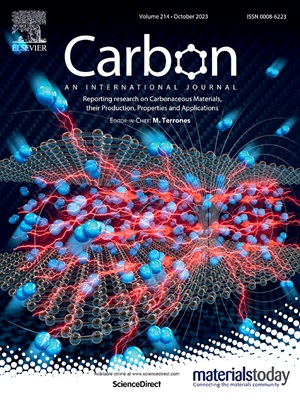Therapeutic effects of an injectable multifunctional thermosensitive hydrogel loaded with ascorbic acid carbon quantum dots and chitosan/chondroitin sulfate complex on periodontitis
IF 11.6
2区 材料科学
Q1 CHEMISTRY, PHYSICAL
引用次数: 0
Abstract
Background
Periodontal disease, an oral disease that initiates with plaque biofilm infection. The osteogenic potential of human periodontal stem cells (hPDLCs) is severely compromised by synergistic periodontal microbes and destructive inflammation. Enhancing the osteogenic potential of hPDLCs in an inflammatory environment remains challenging.
Methods
In this study, we synthesized advanced composite nanomaterials, denoted as CQDs@CH/CS, by incorporating carbon quantum dots (CQDs) derived from ascorbic acid into a chitosan/chondroitin sulfate complex (CH/CS), to facilitate targeted drug delivery to irregular periodontal pockets.
Results
The CQDs@CH/CS demonstrated excellent biocompatibility and anti-inflammatory properties, with a 92 % inhibition rate of P. gingivalis and its biofilm. It effectively enhanced the osteogenic capacity of hPDLCs in both inflammatory and normal conditions. The NLRP1 inflammasome-mediated cellular pyroptosis pathway and the Ca2+/CaM/CaMKⅡα signaling pathway were implicated in CQDs@CH/CS-induced osteogenesis. For in vivo application, CQDs@CH/CS was incorporated into a temperature-sensitive hydrogel, PF-127, and in periodontitis rats, it exhibited significant anti-inflammatory properties and substantially promoted periodontal tissue regeneration.
Conclusions
In summary, CQDs@CH/CS, with its multifaceted antibacterial, anti-inflammatory, and bone repair functions, is a promising carbon-based nanomaterial candidate for periodontitis treatment.

含抗坏血酸碳量子点和壳聚糖/硫酸软骨素复合物的可注射多功能热敏水凝胶对牙周炎的治疗作用
牙周病是一种由菌斑生物膜感染引起的口腔疾病。人牙周干细胞(hPDLCs)的成骨潜能受到协同牙周微生物和破坏性炎症的严重损害。增强hpdlc在炎症环境中的成骨潜能仍然具有挑战性。方法将抗坏血酸衍生的碳量子点(CQDs)掺入壳聚糖/硫酸软骨素配合物(CH/CS)中,制备了先进的复合纳米材料CQDs@CH/CS,以促进药物靶向递送到不规则牙周袋。结果CQDs@CH/CS具有良好的生物相容性和抗炎性能,对牙龈假单胞菌及其生物膜的抑制率为92%。它有效地增强了hpdlc在炎症和正常情况下的成骨能力。NLRP1炎症小体介导的细胞焦亡途径和Ca2+/CaM/CaMKⅡα信号通路与CQDs@CH/ cs诱导的成骨有关。在体内应用中,将CQDs@CH/CS掺入温度敏感的水凝胶PF-127中,在牙周炎大鼠中,它表现出显著的抗炎特性,并显著促进牙周组织再生。结论CQDs@CH/CS具有多方面的抗菌、抗炎和骨修复功能,是一种很有前途的治疗牙周炎的碳基纳米材料。
本文章由计算机程序翻译,如有差异,请以英文原文为准。
求助全文
约1分钟内获得全文
求助全文
来源期刊

Carbon
工程技术-材料科学:综合
CiteScore
20.80
自引率
7.30%
发文量
0
审稿时长
23 days
期刊介绍:
The journal Carbon is an international multidisciplinary forum for communicating scientific advances in the field of carbon materials. It reports new findings related to the formation, structure, properties, behaviors, and technological applications of carbons. Carbons are a broad class of ordered or disordered solid phases composed primarily of elemental carbon, including but not limited to carbon black, carbon fibers and filaments, carbon nanotubes, diamond and diamond-like carbon, fullerenes, glassy carbon, graphite, graphene, graphene-oxide, porous carbons, pyrolytic carbon, and other sp2 and non-sp2 hybridized carbon systems. Carbon is the companion title to the open access journal Carbon Trends. Relevant application areas for carbon materials include biology and medicine, catalysis, electronic, optoelectronic, spintronic, high-frequency, and photonic devices, energy storage and conversion systems, environmental applications and water treatment, smart materials and systems, and structural and thermal applications.
 求助内容:
求助内容: 应助结果提醒方式:
应助结果提醒方式:


